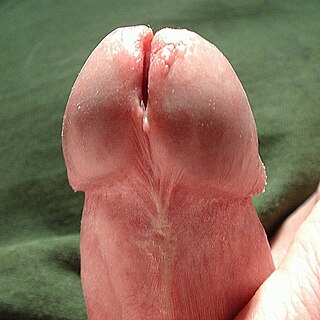
A meatotomy is a form of penile modification in which the underside of the glans is split, extending the urinary meatus. The procedure may be performed by a doctor to alleviate meatal stenosis or urethral stricture. A meatotomy is sometimes also self-performed voluntarily for aesthetic reasons, or to open the urethra for sexual gratification as part of the practice of sounding.
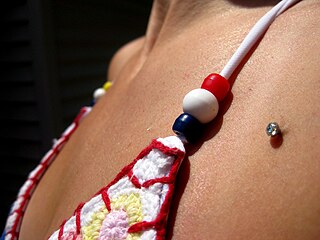
Transdermal implants, or dermal piercings, are a form of body modification used both in a medical and aesthetic context. In either case, they consist of an object placed partially below and partially above the skin, thus transdermal. The skin around it generally heals as if it were a piercing.

Forceps are a handheld, hinged instrument used for grasping and holding objects. Forceps are used when fingers are too large to grasp small objects or when many objects needed to be held at one time while the hands are used to perform a task. The term "forceps" is used almost exclusively in the fields of biology and medicine. Outside biology and medicine, people usually refer to forceps as tweezers, tongs, pliers, clips or clamps.
In modern Western body piercing, a wide variety of materials are used. Some cannot be autoclaved, and others may induce allergic reactions, or harbour bacteria. Certain countries, such as those belonging to the EU, have legal regulations specifying which materials can be used in new piercings.
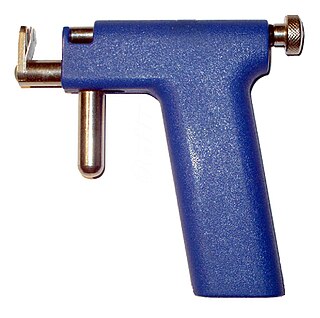
An ear piercing instrument is a device designed to pierce earlobes by driving a pointed starter earring through the lobe. Piercing guns may be reusable or disposable. Piercing guns are typically used in mall jewelry shops.

A surgical instrument is a tool or device for performing specific actions or carrying out desired effects during a surgery or operation, such as modifying biological tissue, or to provide access for viewing it. Over time, many different kinds of surgical instruments and tools have been invented. Some surgical instruments are designed for general use in all sorts of surgeries, while others are designed for only certain specialties or specific procedures. Accordingly, the nomenclature of surgical instruments follows certain patterns, such as a description of the action it performs, the name of its inventor(s), or a compound scientific name related to the kind of surgery.
Scalpelling is a body art procedure similar to body piercing for the creation of decorative perforations through the skin and other body tissue, and is most commonly used as a replacement for or enhancement of ear piercing. Whereas piercing is typically performed with a hollow piercing needle or an ear piercing instrument, scalpelling is performed by using a scalpel to cut a slit into the skin. Unlike dermal punching, no flesh is removed. The technique can immediately produce holes with a larger diameter than can be achieved by piercing. This is a more rapid means of accommodating larger gauge jewellery than stretching, a technique whereby piercings are enlarged by inserting gradually larger jewellery. Scalpelling is performed to quickly achieve a large-gauge piercing, when scar tissue is preventing further stretching, if tissue has thinned to the point where further stretching could cause it to break, or to combine two closely placed piercings into one hole.
A Pennington clamp, also known as a Duval clamp, is a surgical clamp with a triangular eyelet. Used for grasping tissue, particularly during intestinal and rectal operations. Also used in some OB/GYN procedures, particularly caesarian section. Under the name 'Duval clamp' they are occasionally used much like a Foerster clamp to atraumatically grasp lung tissue. The clamp is named after David Geoffrey Pennington, an Australian surgeon who is a pioneer of microsurgeries.

A retractor is a surgical instrument used to separate and manipulate the edges of a surgical incision or wound, or to hold back underlying organs and tissues so that body parts underneath may be accessed.
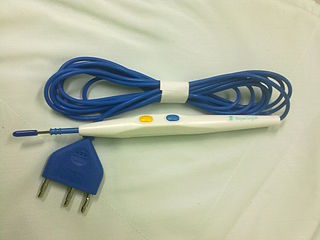
There are many different surgical specialties, some of which require very specific kinds of surgical instruments to perform.
Hemoperitoneum is the presence of blood in the peritoneal cavity. The blood accumulates in the space between the inner lining of the abdominal wall and the internal abdominal organs. Hemoperitoneum is generally classified as a surgical emergency; in most cases, urgent laparotomy is needed to identify and control the source of the bleeding. In selected cases, careful observation may be permissible. The abdominal cavity is highly distensible and may easily hold greater than five liters of blood, or more than the entire circulating blood volume for an average-sized individual. Therefore, large-scale or rapid blood loss into the abdomen will reliably induce hemorrhagic shock and, if untreated, may rapidly lead to death.
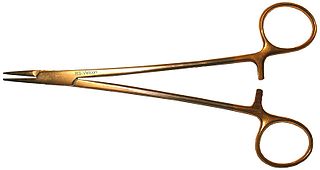
A needle holder, also called needle driver or needle forceps, is a surgical instrument similar to a hemostat, used by doctors and surgeons to hold and push a suturing needle when performing wound closure, ligation and other surgical procedures that require re-anastomosis.
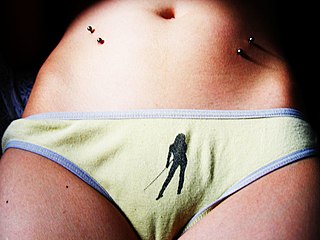
A hip piercing is a piercing in the pelvic area through the skin near the hip bone. Hip piercings are often done in couplets with one on each hip, but it is not unusual to see only one. Hips piercing are a type of surface piercing. Microdermals or skin divers can be implanted in the hip area to give a similar appearance.

Gauze sponges are disposable medical supplies commonly used in medicine and surgery. They are ordinarily made of gauze and are used to absorb blood and other fluids as well as clean wounds. When used in surgery, they are called surgical sponges.
A retained surgical instrument is any item inadvertently left behind in a patient’s body in the course of surgery. There are few books about it and it is thought to be underreported. As a preventable medical error, it occurs more frequently than "wrong site" surgery. The consequences of retained surgical tools include injury, repeated surgery, excess monetary cost, loss of hospital credibility and in some cases the death of the patient.
The Baptist Medical Center sex reassignment surgery controversy occurred in 1977 in Oklahoma City, Oklahoma. Surgeons at the Baptist Medical Center, a hospital owned by the Southern Baptist Convention, were prohibited from performing sex reassignment surgery.
Surgical scissors are scissors specially manufactured as surgical instruments, typically used for cutting sutures, dressings, and cutting and dissecting biological tissue. Surgical scissors are usually made of surgical steel. Some have tungsten carbide reinforcements along their cutting edges, the hardness of which allows manufacturers to create sharper and more durable edges.

Circumcision surgical procedure in males involves either a conventional "cut and stitch" surgical procedure or use of a circumcision instrument or device. In the newborn period, almost all circumcisions are done by generalist physicians using one of three surgical instruments. In the US, the Gomco clamp is the most utilized instrument, followed by the Mogen clamp and the Plastibell. They are also used worldwide.
Electrothermal Bipolar Vessel Sealing (EBVS) is an electrosurgery technology for sealing blood vessels of up to 7mm in diameter. The technology was introduced in 1998 and since then has been used widely for a variety of laparoscopic and open surgical procedures. In addition to sealing blood vessels, modern instruments are designed to grasp and cut a variety of tissues. A number of companies offer EBVS systems including BOWA, Covidien, Conmed, Ethicon Endo-Surgery, Erbe Medical, KLS Martin Group, Olympus and Applied Medical.

An Allis clamp is a commonly used surgical instrument. It was invented by Oscar Allis.

















